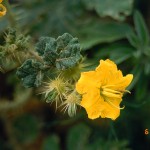Buffalo-bur
Solanum rostratum Dun.
Solanaceae (Nightshade family)
Description
A prickly, annual, warm-season plant of the nightshade family, buffalo-bur typically can grow to 2 feet tall. This plant is considered a weed nearly everywhere it grows.
The leaves, which vary in shape and size, are irregularly rounded and deeply lobed and have spiny veins. The stems are profusely thorned. The yellow flowers appear from May to October, and the fruit is enclosed by a prickly bur.
Buffalo-bur provides only fair grazing for wildlife and is poisonous to livestock. Because of its spiny growth form, it is rarely consumed.
Habitat
Buffalo-bur is common in old fields, roadsides, overgrazed pastures and disturbed areas and near water tanks throughout Texas. A native of the Great Plains, it is found from North Dakota to Texas and westward and south into Mexico.
Toxic Agent
Buffalobur can poison horses, sheep, goats and cattle. However, sheep and goats are more resistant than cattle, and in controlled experiments, goats were not poisoned at all. Its toxic agent is the glycoalkaloid solanine. The leaves and fruit contain solanine at all stages of growth. In some instances, as little as 0.1 to 0.3 percent of an animal's weight in buffalobur is enough to be toxic. Species within the genus Solanum can also accumulate excess nitrates in soils that are high in nitrogen.
Signs of Livestock Ingestion
The glycoalkaloid can cause two types of effects in a poisoned animal. Nervous effects include: Incoordination; Excessive salivation; Loud, labored breathing; Trembling; Progressive weakness or paralysis; Nasal discharge;
Effects of gastrointestinal irritation include: Nausea; Abdominal pain; Vomiting; Diarrhea, sometimes with blood.
Typical nitrate signs may also be exhibited but are much less common. Plant material may be identified in rumen content of dead animals.
Management Strategies
Because buffalobur is unpalatable and mechanically injurious to the mouth, problems occur only in unusual circumstances. Some cases have occurred in cattle grazing very lush wheat pastures (no roughage) suddenly gaining access to areas infested with mature, dead buffalobur. Others have resulted from extreme overgrazing.
Good range management practices can reduce the incidence of livestock poisoning.
If infestations become severe, apply Grazon P+D® at 0.6 to 0.9 pound a.i./acre as an aerial or ground broadcast treatment in spring when plants begin to flower.
For individual plant treatments, mix Grazon P+D® as a 1 percent solution with surfactant and water, and thoroughly wet the leaves using a hand-held sprayer.
Mechanical control practices that disturb the soil surface may make the plant infestations more severe.
Images
Plant Characteristics
Flower Color: Yellow
Seed Type: Fruit/Berry
Duration: Annual
Stem Texture: Prickly, Spiny, or Thorny
Growth Habit: Forbs/Broadleaf
Leaf Shape
 : Simple with Pinnate or Parallel Venation
: Simple with Pinnate or Parallel Venation
Season: Warm
Distribution
 : 01 - Pineywoods, 02 - Gulf Prairies and Marshes, 03 - Post Oak Savannah, 04 - Blackland Prairies, 05 - Cross Timbers and Prairies, 06 - South Texas Plains, 07 - Edwards Plateau, 08 - Rolling Plains, 09 - High Plains, 10 - Trans-Pecos
: 01 - Pineywoods, 02 - Gulf Prairies and Marshes, 03 - Post Oak Savannah, 04 - Blackland Prairies, 05 - Cross Timbers and Prairies, 06 - South Texas Plains, 07 - Edwards Plateau, 08 - Rolling Plains, 09 - High Plains, 10 - Trans-Pecos
Distributions
Distribution refers to the ecological region in Texas that a plant has been found. You can also view a clickable map.
Book: Brush and Weeds of Texas Rangelands (B-6208), Toxic Plants of Texas (B-6105)
Collection: Brush and Weeds, Toxics, Wild Flowers






